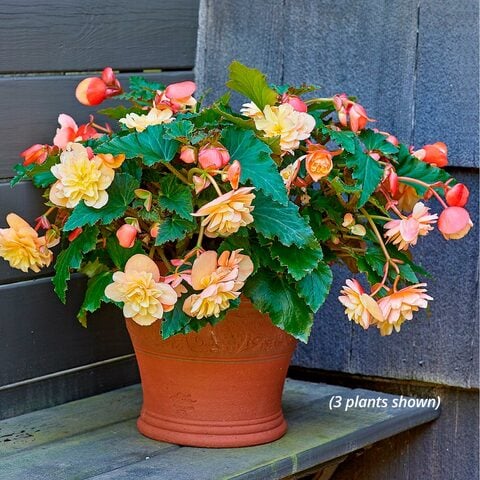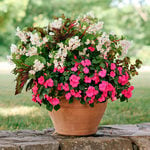Begonia Care
Tuberous Begonia Care
Latin Name Pronunciation: beg-own'ee-uh
Tuberous Begonias are frost-tender plants that thrive where they receive bright light but little or no direct sun. Given an early start, they put on a glorious display all summer long. We grow our Begonias in pots and hanging baskets, but they can also be planted in the ground (once the danger of frost has passed). Either way, unless you live in a frost-free climate, you must lift and store the tuberous roots in fall to carry the plants through winter.
Starting Tubers in Flats or Pots
- To get a jump on a short season, plant tubers on arrival in flats (shallow containers with drainage holes) or 4–5″ pots.
- The potting mix should have a light texture and be well drained; a soilless mix, mixed 3 to 1 with builder's sand, meets both requirements. Begin by placing potting mix and sand in a plastic tub or bucket. Slowly add water and stir until the mix is moist but not soggy. Put moistened mix in the container, stopping about 1½″ shy of the rim.
- Handling the tubers with care (especially if they have begun to produce new growth, which is very fragile), place them, hollow side up, on top of the potting mix. Space the tubers 2–4″ apart in a flat (one tuber per 4–5″ pot) and cover them with ½″ of potting mix. Then water sparingly and place the container in a window that provides bright but indirect light.
- Keep the potting mix moist but not soggy.
- To hasten growth, set the container on a heating mat or a radiator (with a few magazines between container and radiator to prevent overheating). Tubers that have not already begun to sprout when you receive them will generally show signs of growth within 2–6 weeks after planting.
Transplanting
- After the first 2 leaves have emerged, transplant tubers started in flats into 4–5″ pots or, provided the danger of frost has passed, into a lightly shaded outdoor bed that has been amended with organic matter such as compost or peat moss.
- Lift and move the tubers carefully to avoid damaging the roots, and set the top of each tuber 1–2″ below the surface of the potting mix or garden soil. Begonias planted in the ground should be positioned so that the points of the leaves aim at the viewer, because the blooms will face the same direction.
- Plants in 4–5″ pots should be moved into 7–10″ pots when the roots fill the pots. If time and energy permit, a final move to 12″ pots will yield especially spectacular plants.
- Set pots outdoors in a bright but not sunny location when the threat of frost has passed. Tuberous Begonias will not grow well in deep shade.
Staking
- When upright varieties are 4–6″ tall, push a heavy, 18–20″ long bamboo stake (or one of our cushioned, steel Blossom Stakes - Set of 5) into the potting mix or garden soil on the side of the plant opposite the points of the leaves. Place the stake a few inches away from the main stem to avoid injuring the tuber.
- Fasten the plant to the stake with garden twine or soft plastic tape looped in a figure-8 around stem and stake. As the plant grows, you may need more ties to provide additional support.
Summer care
- Tuberous Begonias thrive in soil that is evenly moist but well drained. Soggy soil can cause the stems to snap off at the base.
- Fertilize plants once a month with a balanced (20-20-20), water-soluble fertilizer mixed as directed.
- Keep plants tidy by removing spent flowers; cut the flowers off close to the stem using a sharp knife.
- The only disease that may trouble your plants is powdery mildew, a fungus that appears as white powder on the leaves. Powdery mildew is easier to prevent than it is to cure, and placing your plants in a location where air can circulate freely around them is the best prevention. If you've had trouble with powdery mildew on Tuberous Begonias in the past, you can prevent future outbreaks by spraying with a mild fungicide that you can prepare yourself by mixing one tablespoon of baking soda and 2 or 3 drops of insecticidal soap in a gallon of tepid water. Spray this solution every 10 days during hot, humid weather. Once mildew appears, the only effective remedy is to spray promptly with a commercial fungicide. Follow the directions on the label carefully.
Overwintering
- Allow plants to grow through November (or until frost) to store energy for the next season.
- Force container-grown plants into dormancy by gradually withholding water.
- Dig plants grown in the ground with a ball of soil and let them dry out in a shed or on the garage floor.
- When the stems break free from the tubers, shake off excess soil and allow the tubers to cure in the sun for about 4 days. Then store them in dry peat moss or sand in open flats in a cool (45°–50°F), dry place.
- Replant the tubers as suggested above in late winter.
Growing Hanging Basket Begonias
- Hanging Basket Begonias—varieties with trailing stems—require much the same care as upright Begonias, except that they look their best in a shallow container that can be suspended from the eaves of a house or from an arbor.
- One Hanging Basket Begonia tuber in a 12″ container makes for a spectacular and long-lasting display.
- Please note: If the stems of a Hanging Basket Begonia grow upright and refuse to trail over the edge of the container, plants are not receiving enough light.
For additional information, please watch the following video or refer to the Begonia series of articles on our blog.
How to Grow Tuberous Begonias Video
Fibrous Begonia Care
Latin Name Pronunciation: beg-own'ee-uh
Fibrous Begonias are a diverse group known for their colorful flowers, compact shape, and rounded green, bronze, or variegated leaves. Native to tropical and subtropical regions, they are grown as annuals in cooler areas where they are not hardy. A widely popular bedding and container plant, fibrous Begonias provide a continuous display of color throughout the growing season. With no deadheading of spent blooms required, these Begonias are low maintenance plants making them carefree and well adapted to a variety of garden settings.
Light/Watering: Fibrous Begonias flower well in partial shade to full sun. Bronze-leaved varieties are more suited to full sun. Water moderately once or twice a week during the warmer season.
Fertilizer/Soil and pH: Plant in well-drained soil high in organic matter. Use an all-purpose fertilizer for annuals monthly during the warmer season.
Pests/Diseases: Fibrous Begonias can occasionally be troubled by slugs. Use slug bait, dishes of beer, and diatomaceous earth to discourage them.
Companion Plants: An exceptional container plant, fibrous Begonias pair well with colorful foliage plants such as Caladium, Coleus, and Ipomoea. Or combine in mass plantings with Impatiens and Fuchsia in the garden.
End-of-Season Care: Can be brought indoors in winter in cold climates, and kept in a sunny window.
For information on planting and care of annuals, click here.
Rex Begonia Care
Latin Name Pronunciation: beg-own'ee-uh
Aptly named, these "kings" of the Begonia tribe display gorgeous foliage in wildly variable patterns, colors (including metallic silver), and even shapes (such as the spiral variety called 'Escargot'). Rex Begonias grow from a modified stem structure called a rhizome and are rather exacting in their requirements, but will reward your efforts with a stunning display. Popular as houseplants, Rex Begonias are ideal on a shaded deck or patio, and can light up a shady nook with their striking colors. Flowers are generally insignificant as the brilliant foliage is the main attraction.
Light/Watering: Proper light levels will help bring out the best colors of Rex Begonias. Plants should never see direct sunlight and do well only in bright but filtered light. If light comes mainly from one direction, give each plant a quarter turn every week. The surface of the soil should be allowed to become almost dry between watering during active growth and you must be sure to avoid overwatering. Water with tepid water, not cold water, as it may shock the plants. As days shorten and temperatures drop, plants may enter dormancy—growth stops and leaves may drop. At this time, water only sparingly until new leaves emerge in late winter. Rex Begonias thrive only with high humidity. Dry air will cause the leaf edges to become crisp and dry and plants will languish. Run a humidifier, or simply place potted plants on trays filled with gravel and add water just below top of gravel—do NOT let pots sit in water at any time.
Temperature: Hardy only in zones 10 to 12, Rex Begonias are treated as annuals or as houseplants in colder areas. Moderate daytime temperatures of 65–70°F and nights around 60°F are best. Sudden temperature changes may cause leaves to drop.
Fertilizer/Soil and pH: Fertilize every two weeks beginning in spring when new growth appears with a balanced fertilizer with a 15-30-15 ratio, such as our All Bloom Fertilizer. Taper off feeding in late summer or early fall, and stop in winter, resuming again in spring. A light, free-draining soil high in organic matter is preferred.
Pests/Diseases: Occasionally mealy bugs may appear as cottony white bumps tucked into leaf joints or along the rhizome. Use cotton swabs dipped in rubbing alcohol to wipe off bugs, or spray with insecticidal soap. Two fungal diseases, powdery mildew and botrytis, may occur; good air circulation is essential. Remove dead or diseased leaves promptly as well as any debris on the surface of the planting mix. Good grooming goes far as a preventative, but a systemic fungicide like Funginex may be used if needed.
Companion Plants: Lovely grouped inside or out with other plants that prefer indirect light.
Repotting: Move into larger but shallow pots as required, ideally in spring as new growth begins. Take this opportunity to pinch back tips. If the rhizome has grown over the pot edge, cut it back also, which will force new growth along the rhizome.
Calendar of Care
Early Spring: As new growth begins, resume feeding with a balanced houseplant fertilizer with a ratio of 15-20-15, such as our All Bloom Fertilizer. Repot if needed, using a light, free-draining soil mix rich in organic matter. These plants are shallow rooted, so shallow pots are best. Pinch tips back and trim off the rhizome if it has grown over the pot edge. If plants have been moved to a higher light area for the winter, move them back to their summer spots before the sun becomes too bright.
Mid-Spring: After the danger of frost has passed, plants may be moved outdoors to a shady nook or sheltered patio. Be sure to acclimate them slowly to the new conditions to avoid leaf-drop.
Summer: Continue fertilizing and monitor light levels to avoid burning tender leaves. Continue to scout for insect pests and fungal problems.
Fall: Move plants back into house or greenhouse as temperatures fall below 60°F at night. Quarantine plants until you are certain they harbor no insect pests or fungal diseases. Stop fertilizing.
Early Winter: As the days shorten and temperatures drop, plants may enter dormancy. If this happens, water only sparingly until new growth appears in spring.
For information on planting and care of annuals, click here.
A Tour of the Begonia House at White Flower Farm






